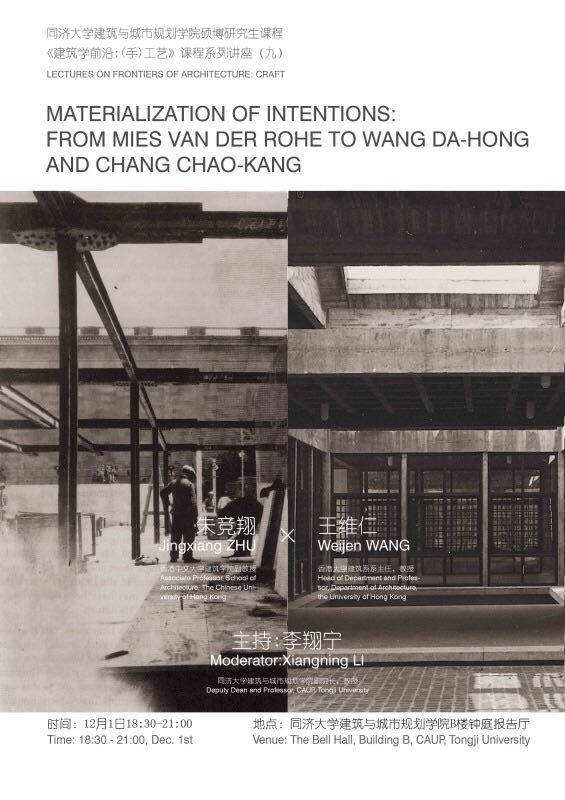新闻中心



同济大学建筑与城市规划学院2015秋硕博研究生必修课《建筑学前沿:(手)工艺》系列讲座第九场。
The Ninth Lecture of the Course Frontiers of Architecture: Craft
题目/Theme:Materialization of Intentions: from Mies to Wang Da-Dong and Chang Chao-Kang
主讲人:王维仁(香港大学建筑系系主任、教授) / 朱竞翔(香港中文大学建筑学院副教授)
Speaker: WANG Weijen(Head of Department and Professor, Department of Architecture, University of Hong Kong) / ZHU Jingxiang(Associate Professor, School of Architecture, Chinese University of Hong Kong)
主持人:李翔宁(同济大学建筑与城市规划学院副院长、教授)
Moderator: LI Xiangning(Deputy Dean and Professor, CAUP, Tongji University)
讲座安排:
1.特邀嘉宾朱竞翔教授讲密斯,大约持续1小时;
2.特邀嘉宾王维仁教授将从张肇康、王大闳、陆谦受这三位建筑师开始结合建造技术与手工艺问题谈传统以及"边缘的现代性“。大约持续1小时;
3.两位嘉宾对谈,李翔宁教授主持,约持续半小时。
Schedule:
1.The speech of Prof.Zhu on Mies lasts for about one hour;
2.The speech of Prof.Wang on Wang Da-hong and Chang Chao-kang lasts for about another hour;
3.Conversation between the two invited speakers, which is hosted by Prof.Li Xiangning, lasts for about half an hour;
时间:2015年12月1日18:30-21:00
地点:同济大学建筑城市规划学院B楼钟庭报告厅
Time: 18:30-21:00, Dec 1st, 2015
Venue: The Bell Auditorium, Building B, CAUP, Tongji University
General Introduction
(1)Can a designer formulate new perception with an aid from industry's growing ability ? How an architect introduces traditional construction method a new life? Mies van der Rohe and Eladio Dieste, genius and pioneer from 20th century, answered such questions through their fabulous influential architectural works. In this lecture, Professor and architect Zhu Jingxiang will review two unprecedented works selected from masters' critical moments, to exemplify comprehensive technology know-how, great sensibility on space and rite, hidden design skills and ever-lasting philosophy.
(2) The lecture examines three architects active in the fringe or the other China during the second half of the 20th century, engaging their modern projects with commitment over the issue of tradition, the paradox that Paul Ricoeur had described: how to become modern and to return to sources? All with origins from South China, spent years in New York or London and Shanghai shortly, eventually practiced in Taiwan and Hong Kong after 1949, demonstrated their concerns over the issue of craft and tradition through their each framing with space, system, material and construction.
